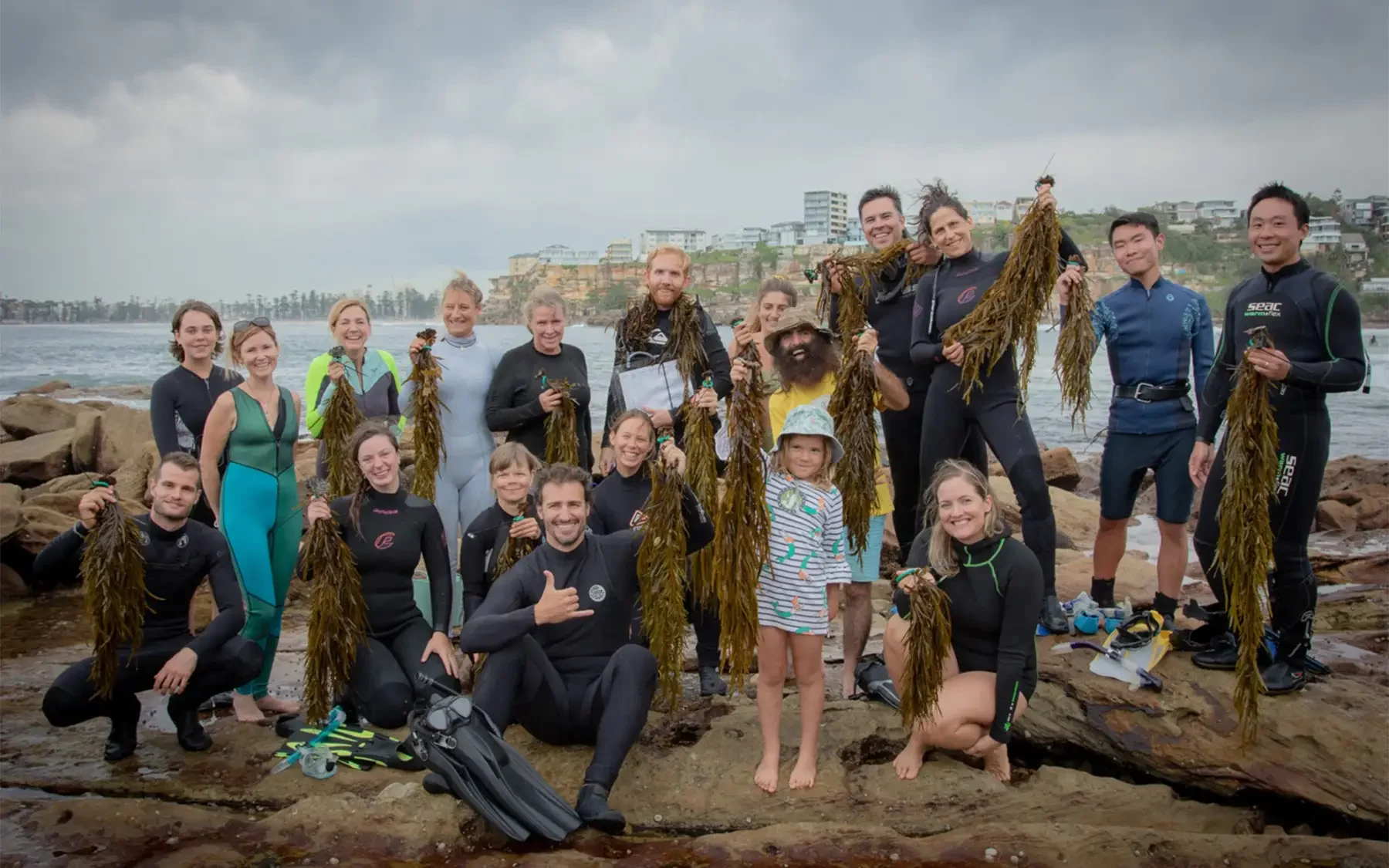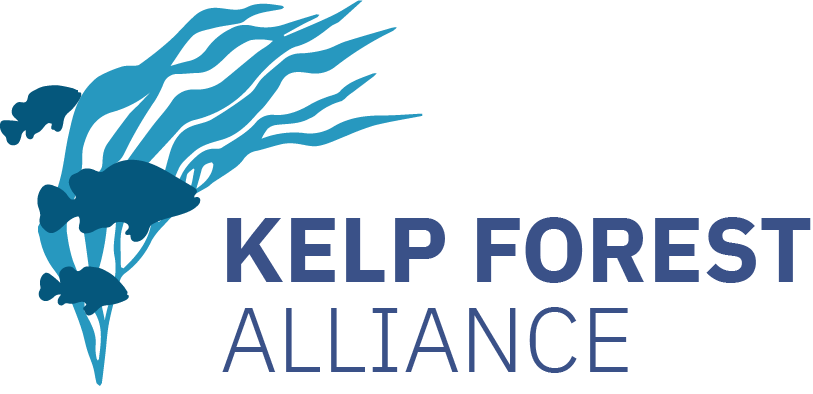Authors: Adriana Vergés, Derrick Cruz, Madelaine Langley, Georgina Wood, Damon Bolton, Alexandra H. Campbell, Melinda A. Coleman, Peter D. Steinberg, Ezequiel M. Marzinelli
Key takeaways
Community engagement, art-science collaborations, and science outreach all cultivated marine stewardship for local kelp forests and helped generate resources for their restoration.
The installation of mesh mats on bare rock with adults tied to the mats can be an effective way to transplant adult kelp in relatively high wave environments.
Community restoration planting in Freshwater (Sydney, Australia). By engaging local communities, the Operation Crayweed project aims to increase awareness about the importance of underwater forests. © Leah Wood
Background
Crayweed (Phyllospora comosa) is one of Australia’s most ecologically important seaweeds, which forms extensive underwater forests along ~5,100 km of coastline in southeastern Australia and around Tasmania. As a foundation species, crayweed supports a unique ecological community that includes two of Australia’s most valuable fisheries: abalone and rock lobster (or crayfish, from which it gets its name). Crayweed completely disappeared from 70 km of Sydney’s metropolitan coastline in the 1980s, although scientists only documented this in the mid 2000s. The disappearance was linked to major sewage pollution at the time. Although water quality improved dramatically along the city’s shoreline following the installation of deep ocean outfalls in the 1990s, populations of crayweed did not re-establish in the region, resulting in a persistent fragmentation of this species’ distribution.
The project
A pilot restoration experiment involving scientists from multiple universities, the New South Wales government, and community volunteers, successfully re-established crayweed at two Sydney sites in 2011. Crayweed from existing populations, north or south of Sydney, were transplanted onto Sydney reefs by scuba divers using mats drilled into the seafloor, cable-ties, and silicon tubing. Survival and reproduction of crayweed, as well as associated biodiversity, were monitored and compared to crayweed forests outside of Sydney and to non-restored sites in Sydney. Transplanted crayweed showed comparable survival rates to natural populations and reproduced in their new habitats. Recruitment rates were higher than in natural populations at one experimental site, while herbivory emerged as an important factor limiting restoration success at the other site. Some components of biodiversity, such as epifauna, started to resemble those found in extant crayweed forests (monitoring continues to date).
A science communication and crowdfunding campaign was launched to raise funds to scale-up crayweed restoration efforts. A name (Operation Crayweed), logo, website (www.OperationCrayweed.com), short film and associated social media pages were created. The crowdfunding campaign was launched in November 2015 and asked the public to “give an underwater tree” for Christmas. The project was featured in multiple national TV news bulletins as well as in national and international print and online media, leading to the team doubling their initial funding target (AU$20,000). These efforts led to an Australian Research Council Linkage grant and significant philanthropic support.
Following this funding success, genetic studies were integrated into the scaling-up of crayweed restoration efforts at five new reefs across Sydney. Donor sites were selected following the genotyping of nearby extant populations in an effort to replicate regional population genetic diversity and structure. Although donor provenance influenced survival, with transplants from northern sites surviving for longer than southern transplants, genotyping of the next generation showed a mix of genes from both north and south populations. Genomics of populations along the entire latitudinal distribution of crayweed is currently being used to identify donor populations/genotypes that may be tolerant of warmer waters in order to future-proof restored sites.
One important aim of Operation Crayweed is to engage local coastal communities in order to raise awareness about the importance of kelp forests and to showcase how science can be effectively used to reverse environmental degradation. One event, Sculpture by the Sea, involved over 100 local school children and attracted over 450,000 visitors. This science, art, and education collaboration has continued throughout the lifespan of the project, leading to field excursions, laboratory lessons, and the creation of a short animated film. The Operation Crayweed team also led a month-long Seaweed Forests Festival in 2021. By combining art, food, and science, this festival engaged people to get them to emotionally invest in the extraordinarily important seaweed ecosystems that underpin the Sydney coastline, the broader importance of seaweed to Australia’s marine ecosystems, and the potential of seaweed to address current world problems.
lifespan of the project, leading to field excursions, laboratory lessons, and the creation of a short animated film. The Operation Crayweed team also led a month-long Seaweed Forests Festival in 2021. By combining art, food, and science, this festival engaged people to get them to emotionally invest in the extraordinarily important seaweed ecosystems that underpin the Sydney coastline, the broader importance of seaweed to Australia’s marine ecosystems, and the potential of seaweed to address current world problems.
The strategy of Operation Crayweed to re-establish crayweed forests along the Sydney coastline of Australia employs/ed an “applied nucleation” approach, whereby crayweed is/was transplanted onto small (<25 m2) plots in different reefs, acting as propagule sources for subsequent natural establishment. Crayweed restoration has been attempted in 16 Sydney reefs over a 10-year period (2011-2021), including sites where scientific experiments tested additional factors such as optimal size of transplant plots, the impact of herbivores, and the importance of genetics. Seven of these 16 sites are now self-sustaining, with crayweed recruiting onto the reefs with expanding distributions and without further interventions from the team (total area ~ 4,300 m2). Biodiversity associated with some of these forests is starting to resemble that found in reference locations. Restoration at three of the other sites started very recently, so it is too early to assess results. In six of the remaining sites, restoration was either fully or partially unsuccessful (few individuals recruited), due mostly to high levels of herbivory and/or burial by sand.
Estimated revegetation costs are US$46,250/ hectare (2018 year of evaluation). This figure includes materials, transport, and personnel, but
The strategy of Operation Crayweed to re-establish crayweed forests along the Sydney coastline of Australia employs/ed an “applied nucleation” approach, whereby crayweed is/was transplanted onto small (<25 m2) plots in different reefs, acting as propagule sources for subsequent natural establishment. Crayweed restoration has been attempted in 16 Sydney reefs over a 10-year period (2011-2021), including sites where scientific experiments tested additional factors such as optimal size of transplant plots, the impact of herbivores, and the importance of genetics. Seven of these 16 sites are now self-sustaining, with crayweed recruiting onto the reefs with expanding distributions and without further interventions from the team (total area ~ 4,300 m2). Biodiversity associated with some of these forests is starting to resemble that found in reference locations. Restoration at three of the other sites started very recently, so it is too early to assess results. In six of the remaining sites, restoration was either fully or partially unsuccessful (few individuals recruited), due mostly to high levels of herbivory and/or burial by sand.
Estimated revegetation costs are US$46,250/ hectare (2018 year of evaluation). This figure includes materials, transport, and personnel, but excludes project management, genomic assessments, and monitoring, as well as initial and ongoing scientific research done to develop and optimise the restoration methods. The figure also excludes outreach activities, such as collaborations with artists and other events.
Lessons learned
It matters when, how, and where transplants are placed within a reef (the best results are obtained when plants are physically transplanted in relatively sheltered areas where donor plants are more likely to persist for longer, near other benthic macroalgae to enhance recruitment and there is higher survival/recruitment over colder seasons).
Some sites may be more vulnerable to herbivores or storms than others and may need more frequent monitoring and multiple plantings before they are successful.
Knowledge of genomics of donor populations allows the restoration of genetically diverse populations and can be used to inform future-proofing strategies.
Associated biodiversity in restored sites may take time to resemble biodiversity in extant, reference forests.
Storytelling/science communication increases engagement, public benefit, and funding for restoration.
Operation Crayweed crew member Damon Bolton attaches adult crayweed from a donor site onto plastic mesh plots, which are drilled onto rocky reefs and removed once self-sustaining populations become established. © John Turnbull
References
1 Campbell, A. H., E. M. Marzinelli, A. Vergés, M. A. Coleman, and P. D. Steinberg. 2014. Towards restoration of missing underwater forests. Plos One 9:e84106.
2 Campbell AH, Marzinelli EM, Gelber J & Steinberg PD (2015) Spatial variability of microbial assemblages associated with a dominant habitat-forming seaweed. Frontiers in Microbiology 6:230 https://doi.org/10.3389/fmicb.2015.00230
3 Coleman, M. A., B. P. Kelaher, P. D. Steinberg, and A. J. K. Millar. 2008. Absence of a large brown macroalga on urbanized rocky reefs around Sydney, Australia, and evidence for historical decline. Journal of Phycology 44:897-901.
4 Coleman MA & Kelaher BP (2009). Connectivity in a subtidal, habitat-forming macroalga with a fragmented distribution. Mar. Ecol. Prog. Ser. 44: 897-901.
5 Layton, C., M. A. Coleman, E. M. Marzinelli, P. D. Steinberg, S. E. Swearer, A. Vergés, T. Wernberg, and C. R. Johnson. 2020. Kelp forest restoration in Australia. Frontiers in Marine Science 7:74.
6 Marzinelli, E. M., A. H. Campbell, A. Vergés, M. A. Coleman, B. P. Kelaher, and P. D. Steinberg. 2014. Restoring seaweeds: does the declining fucoid Phyllospora comosa support different biodiversity than other habitats? Journal of Applied Phycology 26:1089-1096.
7 Marzinelli, E. M., M. R. Leong, A. H. Campbell, P. D. Steinberg, and A. Vergés. 2016. Does restoration of a habitat-forming seaweed restore associated faunal diversity? Restoration Ecology 24:81-90.
8Vergés, A., A. H. Campbell, G. Wood, L. Kajlich, A. M. Eger, D. Cruz, M. Langley, D. Bolton, M. A. Coleman, and J. Turpin. 2020. Operation Crayweed: Ecological and sociocultural aspects of restoring Sydney’s underwater forests. Ecological Management & Restoration 21:74-85.
9 Wood, G., E. Marzinelli, M. Coleman, A. H. Campbell, N. Santini, L. Kajlich, J. Verdura, J. Wodak, P. Steinberg, and A. Vergés. 2019. Restoring subtidal marine macrophytes in the Anthropocene: trajectories and future-proofing. Marine and Freshwater Research 70:936-951.
10 Wood, G., E. M. Marzinelli, A. Vergés, A. H. Campbell, P. D. Steinberg, and M. A. Coleman. 2020. Using genomics to design and evaluate the performance of underwater forest restoration. Journal of Applied Ecology 57:1988-1998.
11 Wood, G., E. M. Marzinelli, A. H. Campbell, P. D. Steinberg, A. Vergés, and M. A. Coleman. 2021. Genomic vulnerability of a dominant seaweed points to future-proofing pathways for Australia’s underwater forests. Global Change Biology 27:2200-2212.





